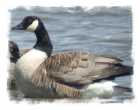

|
|
Nature > Birds > Canada Geese |
|
Web links to more information at the foot of the page |
|  |
|
FEBRUARY - CANADA GEESE Grey squirrels have been described as “rats with good PR”. It sometimes seems that Canada geese could use the professional advice of the squirrels’ public relations experts. These birds are accused of fouling paths, harassing other birds and damaging their habitats, being aggressive to children and spoiling public amenities. Not to mention being a hazard to low flying aircraft! Their noisy flocks can be regarded as a nuisance where they congregate in large numbers, such as in recreation areas or parks. Outside urban areas, the complaint is that the Canada geese eat or trample pasture grass and clip the tops off cereal crops. Farmers are allegedly shooting them, notwithstanding their supposedly protected status. Where these birds come into conflict with human self-interest,
commercial or recreational, they can get a bad press. They are
often the subject of conservation controversy. Over breeding, and over here…..
The population of Canada geese in this country apparently remained low and stable until after World War II, when their numbers started to increase rapidly. Gravel extraction as a result of post-war house and road building produced ideal habitats, particularly in the Home Counties and southern England. There are now estimated to be about 47,000 breeding birds, supplemented by a further 15,000 or so winter visitors. Geese live in local populations, usually of up to a few hundred birds, remaining close to suitable habitats for breeding and roosting. Because the geese have relatively few predators, can live up to thirty years with low adult mortality, and can produce four or five young per year, numbers at particular sites can grow very rapidly. Their numbers are still increasing, but recent evidence suggests that the population in urban areas is now levelling out, possibly due to competition for nesting sites or targetted management of their numbers (see below). Uncontrolled feeding by the general public can be a major cause of over-population of Canada geese in areas too small to sustain them naturally. Recognition:
Like other geese, they are gregarious, and often can be seen flying together in a V-shaped or diagonal line formation. They are present in the UK all year round.
Adult geese moult their flight feathers and become
flightless for about three to four weeks during the Summer. Where to see?: They are found on inland bodies of fresh water such as lakes, reservoirs and large ponds, sometimes reservoirs and gravel-pits, and are frequently seen in suburban areas and parks. Canada geese are grazers so are often found on grassland. In Barford, the River Avon flood plain to the north of the village is an ideal location to spot a “gaggle”. They feed in shallow water, or on pastures and arable land,
with their diet being made up mainly of seeds, roots, grasses
and aquatic plants. What do they sound like?: Canada geese are easily recognised by their loud “honking” calls.
These can act as excellent alarm clocks for river-side
Barford residents in Springtime (if you want to be woken up at 5:30am
that
is). Managing their numbers: The Canada goose like all other birds in Britain, is protected under the EC Wild Birds Directive implemented in the United Kingdom through the Wildlife and Countryside Act 1981. It is an offence to kill, injure or take any wild bird, or damage or destroy their nest or eggs, except with a licence. Canada Geese may, however, be shot during the open season (September 1st to January 31st). Shooting is rarely effective in reducing numbers
at a particular site, as other birds simply move in to replace
those shot. Many methods to control Canada geese and limit their
numbers
have been tried. These include scaring, and physically
deterring them
from their favoured areas using specially designed fencing. Usually,
a combination of methods is employed where the birds are deemed
to be a "nuisance".
|